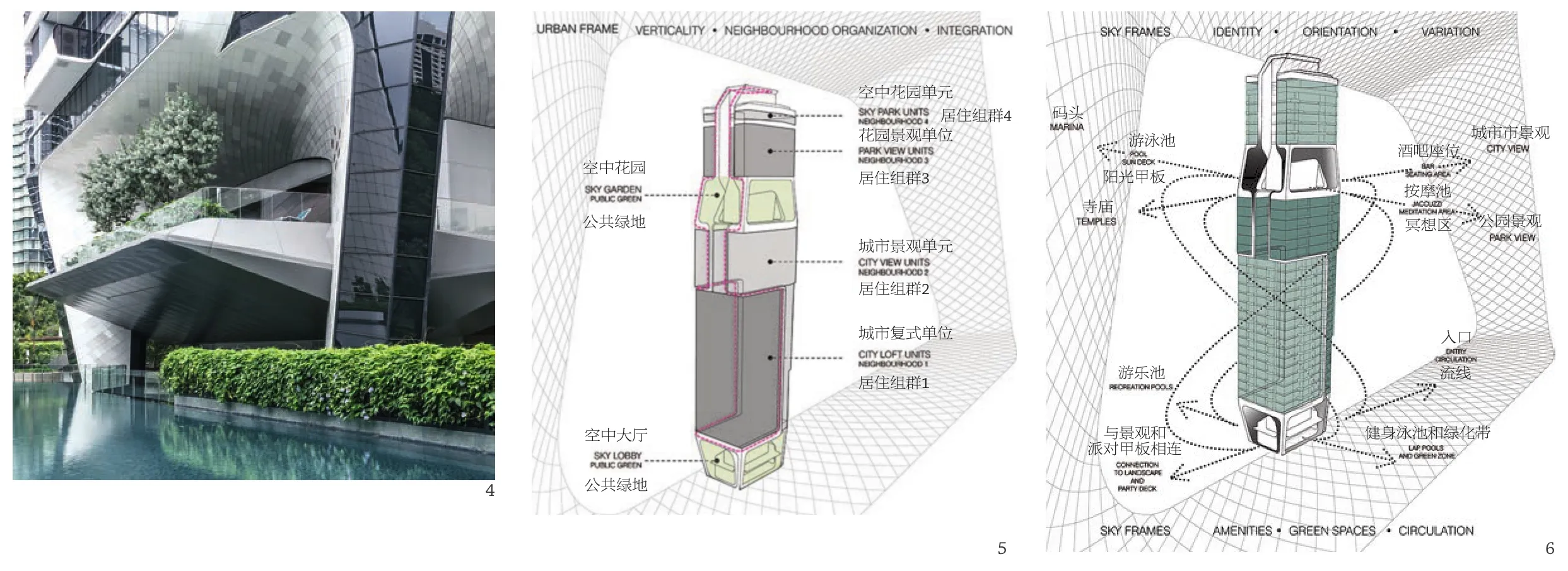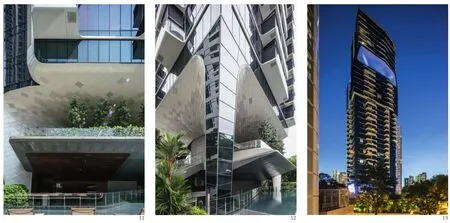斯科茨大楼,新加坡
建筑设计:UNStudio
Architects: UNStudio
斯科茨大楼 SOHO公寓位于新加坡的黄金地段,靠近乌节路豪华购物区,眺望邻近公园和新加坡城市全景。
该塔楼拥有18,500m2、共231个居住单位,包含一至三居室的公寓、四居室的楼顶公寓、宽敞的绿植园林、空中花园、楼顶公寓顶层花园以及各种娱乐设备。
UNStudio创始人及首席建筑师本·范·贝克尔表示:“这个大楼是新加坡城市的一个趣味点,跳出了一般的惯常设计手法,我们创造了一个空中的街区,一个每个区域都拥有独特功效的垂直城市。”
空中邻里
斯科茨大楼的建筑理念是一个融合多种居住类型和规模的“垂直城市”。同时,空中平台、楼顶公寓顶层花园和独立阳台形式的户外绿化区域构成了设计的重要元素。塔楼的垂直城市概念取自“城市”“邻里”和“家”。
城市
垂直城市的概念与绿化区域通过两种形式紧扣在一起:“垂直框架”和“天空框架”。垂直框架以城市方式组织塔楼。它将塔楼整合为一个“垂直城市”,将4个住宅群划分为不同的小区。
小区
4个相互堆叠的住宅群体被设计成不同功能和定制的生活模式。一居室城市阁楼公寓位于较低的天空框架上方,组成塔楼的低层部份。第二组城市景观单位(两居室公寓)面向相邻的良木山,位于一居室公寓之上。园景单位则置于第二个天空框架上方。而塔楼最后一个住宅群体包含了3个独特的楼顶公寓,并拥有私人屋顶阳台。
家
通过户外空间的类型、规模、布局和连贯性以及室内布局个性化的可能性,为每个单位提供独特的身份。
本·范·贝克尔指出:“斯科茨大楼中的阳台与单独框架区域的分区相互连结,在结构中创造出不同的细节尺度,既有复杂、细小的细节也有较大的形态细节。在斯科茨大楼中,阳台构成室内家具的一部分。”
园林、娱乐及空中框架
塔楼西侧附近的绿色区域最初通过Sitetectonix设计的地面景观概念延伸到斯科茨大楼地块。这个地面层概念形成一个多层环境,将居民可用的不同空间和娱乐设施连接在一起。
花园内的娱乐设施包括一个带阳光甲板的50m游泳池、儿童游泳池、餐厅和烧烤亭、会议区以及按摩和健身室。
较低的天空框架平台“空中大厅”构成通往公寓的绿化通道,位于通往大楼的通道上方8m处。这个平台可以将花园的自然景观垂直延伸到塔楼。
第二个天空框架平台“空中花园”在第三个小区上方,提供全方位景观,并可用作户外活动的社交平台。空中花园层设有按摩池、游泳池和用餐平台等设施。
大堂设计
青翠的景观连接了公共户外空间,而塔楼升降机大厅通过使用天然材料将自然景观引入到室内。
大堂空间主要以柔和的木制线条和优雅的大理石地板饰面强调自然元素,其余部份则采用白釉玻璃以反映和扩大空间。
大理石砖(90cm×90cm)以随机图案布置在地板上,并延伸到大堂墙身,藉以扩展视觉空间。曲线木制的线条折叠在天花上并横跨大厅连接大堂两端,为空间注入活力和暖意。
整个大厅采用的弯曲木制线条与塔楼外部,特别是白色金属框架遥遥呼应。
项目信息/Credits and Data
客户/Client: 远东机构/Far East Organisation
设计建筑师/Design Architect:
UNStudio: Ben van Berkel, Astrid Piber with Ger Gijzen,Konstantinos Chrysos, Luis Etchegorry, Cynthia Markhoff,Elisabeth Brauner, Shany Barath, Thomas van Bekhoven,Iris Pastor, Rodrigo Cañizares, Albert Gnodde, Mo Ching Ying Lai, Grete Veskiväli, Philipp Weisz, Samuel Bernier Lavigne, Lukasz Walczak, Alicja Chola, Cheng Gong
执行建筑师/Executive Architect: ONG&ONG, Singapore
项目管理/ Project Management: Arcadis, Singapore
顾问/ Advisors:
景观建筑师/Landscape Architect: Sitetectonix, Singapore
结构工程师/Structural Engineer: KTP Consultants,Singapore
机械工程师/Mechanical Engineer: United Project Consultants, Singapore
室内设计(住宅单位)/Interior Design (Residential Units): Creative Mind Design, Singapore
效果图/Visualisations: rendertaxi, Aachen
摄影/Photos: Darren Soh, EdmonLeong

1 首层游泳池和花园区/Ground level pool and garden area
2 塔楼的3个邻里概念/Three neighbourhood concept of the tower
3 在黄金地段的垂直城市理念/Vertical city concept on a prime location

The Scotts Tower SOHO apartment building is situated on a prime location in Singapore, close to the Orchard Road luxury shopping district and with views encompassing both nearby parkland and the panoramic cityscape of Singapore City.
The 18,500m2, 31-storey, 231-unit tower consists of 1 to 3-bedroom apartments and 4-bedroom penthouses, along with expansive landscaped gardens, sky terraces, penthouse roof gardens and a variety of recreational facilities.
Ben van Berkel: "An interesting facet of The Scotts Tower is the way that it reacts to the urban context of Singapore. Instead of the more usual means of planning a city horizontally, we have created neighbourhoods in the sky: a vertical city where each zone has its own distinct identity."
Neighbourhoods in the Sky
City
The three elements of the vertical city concept,along with the green areas, are bound together by two gestures: the "vertical frame" and the "sky frames".
The vertical frame organises the tower architecturally in an urban manner. This frame affords the tower the vertical city effect by dividing the four residential clusters into different neighbourhoods.
Neighbourhoods
The four residential clusters that are stacked on top of each other are each designed for versatile and customised living. Situated above the lower sky frame, the one bedroom City Loft residences pixelate the lower tower.
The second cluster of the City View units (two bedroom apartments) face the adjacent Goodwool hill on the lower part of the tower and continue above the first package.
Park View units form the next cluster, above the second sky frame. Crowning the tower is the final cluster containing three exclusive Penthouse residences that also have private rooftop terraces.
Home
(3)采用专家问卷调查方式,结合TCCI、TCS、TCL的发展规律,对TCCI进行了归百化处理,建立了对应的百分制评价指标TCEI,并初步确定了我国高速公路沥青路面横向裂缝评价标准及维修标准。
Individual identity is given to each unit by means of type, scale, distribution and articulation of outdoor space, along with the possibility for personalisation of the interior layout.
Ben van Berkel: "The balconies, combined with the zoning of the individually framed neighbourhoods, in the Scotts Tower create different scales of detail in the structure; both intricate, smaller details and larger gestural details. In The Scotts Tower the balconies form part of the interior furniture."
Gardens, Recreation and Sky Frames
The nearby green area to the West of the tower is extended into The Scotts Tower site initially by means of a ground level landscape concept designed by Sitetectonix. This ground level concept incorporates a multi-layered environment which links together the different zones and recreational facilities available to the residents.
Recreational facilities within the gardens include a 50 metre lap pool with sun deck, a children's pool,a wellness pool, dining & BBQ pavilions, a meeting pavilion and massage and gym pavilions.
A green gateway to the residences is created by the lower sky frame terrace, the "sky lobby", which is located eight meters above the access routes to the building. This terrace serves to continue the natural landscape of the gardens vertically into the tower.
A second sky frame terrace, the "sky garden"is introduced above the third cluster, offering panoramic views and the possibility for use as a social platform for outdoor events. Facilities such as Jacuzzi pools, a swimming pool and a dining deck can be found on the sky garden level.
Lobby Design
A verdant landscape unifies the communal outdoor spaces. An extension of this quality, through the use of natural materials, was the primary design intention for the lift lobbies of the tower.
The two main elements of the lobby spaces are the warm wooden ribbons and the elegant marble floors.These elements clad the primary parts of the lobbies(lift entrance walls and circulation) in order to create emphasis, while the technical cores are clad with white back-painted glass to reflect and enlarge the space.
Marble tiles (90 cm × 90 cm) are arranged on the floor in a random pattern and extend upwards on the lower part of the lobby walls to extend the space. Above this, curvilinear wooden ribbons fold on to the ceiling and span across the lobby,connecting both ends and introducing motion and residential warmth into the space.
The soft curves that characterise the wooden ribbons used throughout the lobbies link to the language found on the exterior of the tower and the white metal frame in particular.

4 契合户外空间的生活/Customised living with articulation of outdoor spaces
5 垂直结构与两个有共享设施的空中花园相结合/The vertical frame incorporates two sky frames with shared amenties
6 空中花园组织塔楼的视野、空间和绿化/Sky frames organise the views, spaces and green areas of the tower

7 各种阳台连接室内和室外空间/A variety of balconies connect the indoor and outdoor spaces
8 户外公共空间采用自然材料/Communal outdoor spaces are made from natural materials
9 空中花园的游泳池可以看到城市景观/Lap pool on the sky garden with views across Singapore

10 鸟瞰/Aerial view
评论
龙灏:阳台,本是居住建筑中绝无仅有的可以较大地影响建筑造型、塑造建筑个性的元素,无论位置、形式还是材料、构造。就空间而论,本方案中的大部分阳台本身只是正常的居住套型外的阳台而已,但建筑师通过对设计任务的充分理解与思考,将不同套型与各种公共功能和景观空间进行了垂直分区组合,构建了一个融合多种居住类型和规模的“垂直城市”,套型外的私家阳台在外立面上的组合直接表达了建筑中不同规模套型组合关系的垂直变化,空中外挑的较大规模花园阳台不仅成为景观优美的居民公共活动与交往空间,同时也与尺度较小的套内私家阳台形成了造型的对比变化,建筑主体深色背景下,设计手法又互相呼应的白色私家阳台栏板及纵跨多层的公共空间外部造型,最终共同造就了该建筑独特的、可谓“鹤立鸡群”的外在形象,将自身从形象很容易雷同的“芸芸众宅”中凸显了出来。
范路:在新加坡斯科茨大楼项目中,各种阳台和空中平台的复杂组织,充分体现了“垂直城市”这一设计理念。这个融合多种居住类型的塔楼,在竖向上按住宅群分为4个不同的小区——从低层的一居室公寓区到顶层的四居室公寓区。此外,两个大尺度的天空架构空中平台分别位于大楼底部和中上部。它们不仅赋予大楼强烈的形式特征,还为楼内居民提供公共活动空间,更与周边城市景观相望,让“垂直城市”融入更大范围的城市空间。
Comments
LONG Hao: The balcony is a unique element in residential buildings that can greatly influence the shape of the architecture while forming the personality of the architecture, from the location and form to the materials and structure. In terms of space, most of the balconies in this project are simply the balcony outside the normal residence type. However, by fully understanding and thinking about the design task, the architects combined different residence types with a variety of public facilities and landscape space in vertical division,thus creating a "vertical city" that incorporates various residence types and scales. The combination of private balconies on the exterior façade directly demonstrates the vertical change of the relationship between different types of units in the building. The larger-scale garden terrace that projects outwards not only becomes a space for public activity and communication with a beautiful landscape, but it is also in contrast to the smaller private balconies in terms of shape. In the dark background of the building body, this design approach together with the white railing of private balconies and the exterior shape of the multi-story public space, creates the unique and "towering" external image of the architecturestanding out from the "crowd of residential buildings"whose images could easily be identical. (Translated by Dandan Wang)
FAN Lu: In the project of Scotts Tower in Singapore,"vertical city" is the main concept which is embodied by the organisation of different types of balconies and sky terraces. The Scotts Tower incorporating a variety of residence types and scales is divided vertically into four residential clusters or neighbourhoods-from 1-bedroom City Loft residences situated in lower floors to 4-bedroom penthouses. Furthermore, two big scale sky frames terraces are arranged in lower part and upper part of the tower. They bring about a strong formal character, provide social platform for residents living high above, serve to continue the natural landscape into the tower, and offer panoramic city views.

11 屋顶花园是居民的绿色通道/Sky frame terrace is the green gateway for the residents
12 外景/Exterior view
13 夜景/Night view

